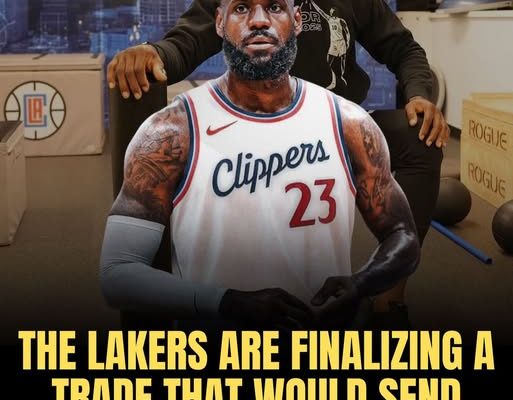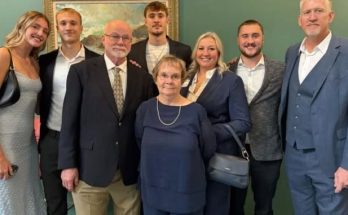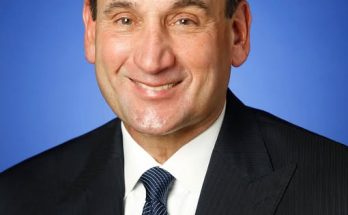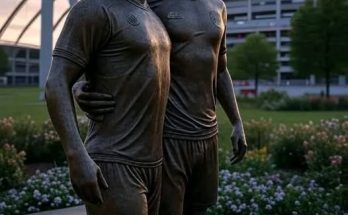BREAKING: The Los Angeles Lakers are finalizing a trade that would send LeBron James to the L.A. Clippers for Kawhi Leonard, per league sources. In what may be the most shocking and unprecedented move in the history of the NBA, two of the biggest superstars of the modern era—LeBron James and Kawhi Leonard—are reportedly set to swap Los Angeles jerseys. The implications of this trade reverberate far beyond the city of L.A. This is not just a basketball transaction; it’s a seismic shift in the balance of power in the NBA, a media spectacle of biblical proportions, and an emotional rollercoaster for two fanbases who never imagined their franchise cornerstone would suit up for their crosstown rival.
For the Lakers, this is a decision that will define the next decade. Trading LeBron James is not merely a roster move—it is a bold and perhaps desperate recalibration of identity, ambition, and strategic direction. LeBron James has been the face of the Lakers since his arrival in 2018, delivering a championship in the bubble in 2020 and providing stability, relevance, and star power to one of the NBA’s most storied franchises. But at age 40 and entering his 22nd NBA season, even LeBron’s greatness cannot defy time forever. The Lakers have been at a crossroads: cling to the remnants of the LeBron-Anthony Davis era, or pivot toward a new chapter.
That new chapter now reportedly begins with Kawhi Leonard. And that comes with its own set of questions, baggage, and calculated risk. Kawhi is six years younger than LeBron, a two-time Finals MVP, and a Southern California native who famously chose the Clippers over the Lakers in 2019. His skillset—elite defense, methodical offensive execution, and late-game poise—is tailor-made for postseason basketball. However, he also comes with a long medical history and unpredictable availability. Leonard has not played a full NBA season in years, and his quiet, calculated demeanor is the polar opposite of the media-savvy, spotlight-commanding LeBron James. This is a fundamental culture shift for the Lakers.
For the Clippers, acquiring LeBron James is an all-in push to win now and finally climb the championship mountain that has eluded the franchise since its inception. Owner Steve Ballmer has spared no expense in trying to build a winner, constructing a $2 billion arena, paying one of the highest luxury tax bills in the league, and keeping faith in the Kawhi-Paul George experiment long after others would’ve bailed. With Paul George now in Philadelphia and Kawhi on his way to the purple and gold, LeBron’s arrival signals a new and audacious attempt to seize control of the L.A. market—and perhaps, finally, a Larry O’Brien Trophy.
LeBron moving across the hallway in Crypto.com Arena doesn’t just alter the roster—it rewrites NBA history books. This would mark the first time in NBA history that a player of LeBron’s stature has been traded in the twilight of his career to a direct rival within the same city. It would also be a poetic twist for two stars who have danced around each other for years. Leonard and LeBron were supposed to face off in the 2020 Western Conference Finals, before the Clippers’ infamous collapse in the bubble to the Denver Nuggets. That battle for Los Angeles never happened. Now, they swap uniforms instead of punches in a playoff series. It’s not what anyone predicted, but it’s what we’ve got.
For LeBron, this move may be the final strategic play in a career defined by calculated decisions. Joining the Clippers might offer him something the Lakers couldn’t anymore: a fresh competitive edge, a renewed supporting cast, and perhaps more say in the roster construction for one last dance. It could also provide leverage in how the twilight of his career unfolds, including where and when he eventually plays with or against his son, Bronny James. LeBron has made it clear he wants to play with Bronny before retiring. That ambition—paired with a changing Lakers timeline—could have accelerated the need for a trade.
Leonard, meanwhile, returns to a Lakers team that has always loomed in the backdrop of his career. He grew up a fan of Kobe Bryant and was rumored to have seriously considered the Lakers before ultimately choosing the Clippers in free agency. Now, he walks into the franchise he once spurned, tasked with filling the shoes of one of the greatest players of all time, under the brightest lights in basketball. Leonard’s quiet persona and detached style may actually benefit the Lakers if they’re ready for a reset in tone and identity. Pairing him with Anthony Davis could form the league’s most defensively intimidating frontcourt—assuming health cooperates.
The ripple effects of this trade are impossible to overstate. Fan reactions are expected to be intense and emotional. LeBron loyalists within Lakers Nation may feel betrayed or heartbroken, especially after years of investing in his leadership and brand. Others may welcome the change, acknowledging the need to move on from an aging superstar to prioritize a younger, more sustainable core. Clippers fans may feel a surreal mix of excitement and apprehension. LeBron has long been viewed as the face of the other L.A. team. Can he truly be embraced as a Clipper legend in the making, or will this always feel like a borrowed chapter?
From a basketball standpoint, the move gives both teams a chance to redefine their systems. Ty Lue, who coached LeBron to a championship in Cleveland, reunites with him on the Clippers—a massive advantage in terms of familiarity and mutual trust. The Clippers’ system, which has often relied on isolation-heavy offense, could become much more dynamic with LeBron’s playmaking added to the equation. The Clippers also have a deeper supporting cast at the moment—players like James Harden, Norman Powell, Ivica Zubac, and Terrence Mann can play off of LeBron’s high IQ game in meaningful ways. It’s not hard to imagine a lethal offensive machine fueled by Harden and LeBron orchestrating one of the most unselfish teams in basketball.
The Lakers, meanwhile, get younger and more versatile on the wing with Leonard. If healthy, Kawhi gives them an elite two-way player who doesn’t require heavy usage to be effective. His ability to create his own shot, defend the opponent’s best scorer, and hit clutch midrange jumpers brings a different rhythm to L.A.’s offense. The Lakers may look to pair Leonard with another guard in the trade market to fully reshape their identity post-LeBron. Rumors have already linked them to interest in players like Dejounte Murray, Malcolm Brogdon, and even a potential reunion with Kyle Kuzma. The Anthony Davis-Kawhi Leonard tandem is a tantalizing idea—two of the best defenders of this generation anchoring both ends of the court.
This trade also has serious implications for the rest of the league. Teams in the Western Conference—especially powerhouses like the Denver Nuggets, Minnesota Timberwolves, and Golden State Warriors—now have to reassess the pecking order. A Clippers team with LeBron and Harden may pose a more immediate threat than the previous Kawhi-George pairing, which too often faltered in key moments. The Lakers, assuming Leonard’s health, may actually become a more defensively robust team built for playoff attrition. And most importantly, this swap ensures that the city of Los Angeles remains at the epicenter of basketball discussion for years to come.
From a business perspective, the move is monumental. Merchandise sales, ticket demand, and local television ratings are all expected to surge. LeBron moving to the Clippers gives that franchise a face it has never had in its history. No disrespect to Elton Brand, Chris Paul, or Blake Griffin, but none of them ever carried the global marketing power of LeBron James. With LeBron now a Clipper, Crypto.com Arena is likely to be filled with more Clippers jerseys than ever before. Meanwhile, Leonard in the purple and gold will open up new branding avenues and potentially revive his star appeal, especially if he delivers results in the postseason.
There will also be consequences in the media narrative and player agency landscape. This trade could signify a paradigm shift in how player movement is evaluated, particularly when it involves all-time greats. For years, the idea of trading LeBron James was unthinkable. Now, it’s a reality. That changes the rules for how organizations manage aging stars, how players negotiate influence, and how fanbases prepare for inevitable change. LeBron himself helped usher in the player empowerment era. Ironically, his own trade may mark the next evolution of that era—where even legends are not immune to transactional reality.
How this trade will ultimately be judged depends on results. If LeBron leads the Clippers to their first-ever NBA championship, the move will be hailed as genius. If Kawhi Leonard reinvents the Lakers and brings them back to contention, the trade will be seen as a masterstroke for both sides. But if injuries persist, chemistry flounders, or titles remain elusive, the deal could go down as a cautionary tale about star-chasing and identity crises. Still, in a league driven by boldness, this is the type of move that commands attention, demands scrutiny, and rewards those with vision.
In the end, the image of LeBron James wearing Clippers colors and Kawhi Leonard donning the purple and gold will forever be etched into the NBA’s collective memory. It’s a reminder that in today’s league, nothing is sacred and everything is on the table. Franchise legends can be traded. Rivals can become allies. And dynasties can rise—or fall—with a single transaction. The Lakers and Clippers have made their moves. The rest of the basketball world now waits to see who won, who lost, and who changed the game forever.



